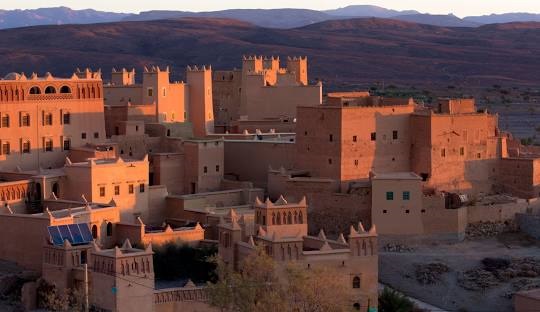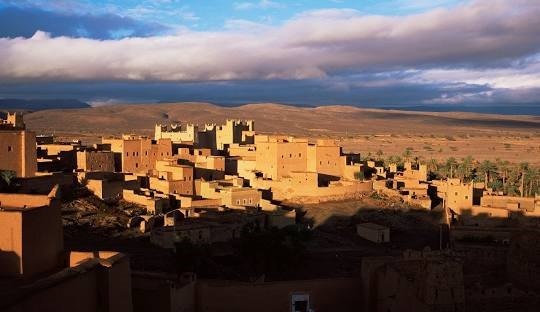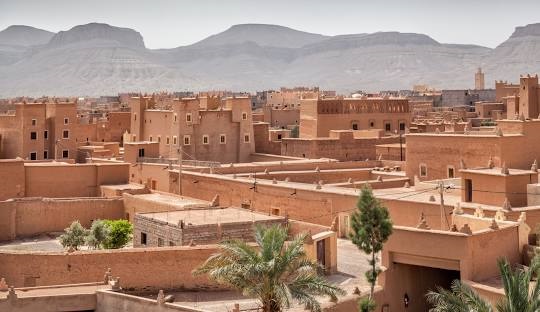Nkob, a small, picturesque village in southeastern Morocco, is a place that might not immediately ring a bell to many travelers. Nestled in the rugged landscapes of the Draa-Tafilalet region, Nkob is a hidden gem that offers a unique blend of history, culture, and natural beauty. Its charm lies in its remoteness, its rich cultural heritage, and the stunning desert scenery that surrounds it.
Nkob
For those seeking an authentic Moroccan experience, far from the bustling medinas of Marrakech or the crowded beaches of Agadir, Nkob presents an ideal destination. Nkob is steeped in history, with roots that stretch back centuries. It is one of the 45 villages that make up the region historically known as the Ait Atta confederation, a Berber tribe renowned for its fierce independence and deep cultural traditions.
The Ait Atta played a significant role in resisting colonial forces, and their legacy is still evident in the village’s way of life today. Its historical architecture reflects its rich past, with numerous fortified homes and villages dotting the landscape. These structures, made of mud and straw, are remarkable examples of Berber architecture, designed to withstand the harsh desert climate.
The village itself is a collection of these ancient mud-brick fortified homes, many of which are still inhabited by local families. These structures, with their thick walls and small windows, are not only aesthetically pleasing but also functional, providing cool relief from the intense desert heat. Walking through the narrow, winding streets of Nkob feels like stepping back in time, where modernity meets tradition in a harmonious blend.
The culture of Nkob is deeply rooted in Berber traditions, which are still vibrantly alive. The local population speaks Tamazight, one of the Berber languages, and their customs and way of life are a testament to a rich cultural heritage that has been passed down through generations. Traditional music and dance play a significant role in community life.
These are performed in occasions such as weddings, religious festivals, and harvest celebrations being marked by lively performances of Ahidous, a traditional Berber dance. The villagers of Nkob also take great pride in their craftsmanship. Handicrafts are an integral part of the local economy, with many families engaging in weaving, pottery, and jewelry-making.
The traditional rugs woven by the women of Nkob are particularly renowned for their vibrant colors and intricate patterns, each telling a unique story or representing a specific aspect of Berber culture. Visitors to Nkob often have the opportunity to visit local workshops, where they can witness these crafts being made and purchase authentic, handmade souvenirs.
Nkob is located at the edge of the Sahara, offering breathtaking views of the surrounding landscape. The village is perched on a rocky outcrop overlooking a vast plain, with the dramatic peaks of the Saghro Mountains serving as a stunning backdrop. This range, with its jagged cliffs and deep gorges, is a popular destination for trekking and hiking, attracting adventurers from around the world.
The region around Nkob is characterized by its arid, desert climate, with hot summers and mild winters. However, this harsh environment has its own unique beauty. The landscape is dotted with date palms, which thrive in the desert oasis, and during the spring, the valley comes alive with a burst of color as wildflowers bloom.
The contrast between the lush green of the palm groves and the red and orange hues of the desert sands creates a mesmerizing spectacle. Nkob is also located near the Draa Valley, one of Morocco’s most scenic and fertile regions, fed by the longest river in Morocco, and is famous for its terraced fields, date palm groves, and traditional Berber villages.
The valley has been a vital source of life for the region’s inhabitants for centuries, providing water and sustenance in an otherwise harsh environment. Tourism in Nkob is still in its infancy, which adds to its charm. Unlike Morocco’s more famous destinations, Nkob offers an unspoiled experience, free from the throngs of tourists and the commercialization that often accompanies them.
This makes it an ideal destination for those looking to experience authentic Moroccan culture and hospitality. Our accommodation in Nkob is provided by a small, family-run traditional guesthouse, which offers a comfortable and welcoming environment. Our accomodation is located in a restored fortified village, allowing visitors to experience traditional Berber architecture and design firsthand.
Staying in a traditional house in Nkob provides an intimate glimpse into local life, with hosts often sharing stories about the village’s history, culture, and customs. Visitors to Nkob can enjoy a variety of activities, from exploring the village and its surrounding foritfied villages to embarking on guided treks into the Saghro mountains.
For those interested in learning more about Berber culture, our guesthouse offers cooking classes where guests can learn how to prepare traditional Moroccan dishes, such as tagine and couscous, using locally sourced ingredients. Another one of the highlights of visiting Nkob is the opportunity to experience the region’s unique festivals and celebrations.
The most notable of these is the Date Harvest Festival, which takes place in the autumn. During this time, the entire village comes together to celebrate the harvest, with music, dance, and feasting. It’s a vibrant and joyous occasion that provides visitors with a firsthand experience of Berber culture and beautiful hospitality.
Getting to Nkob is part of the adventure. The village is located about 140 kilometers east of Ouarzazate, a city known as the gateway to the Sahara. The journey to Nkob takes travelers through some of Morocco’s most stunning landscapes, including the dramatic Tizi n’Tichka Pass and the Draa Valley. The road is winding and can be challenging, but the views are more than worth it.
Travelers are rewarded with sweeping views of the Atlas Mountains, expansive desert plains, and the occasional sighting of a camel caravan making its way across the dunes. While the journey to Nkob requires some effort, it is precisely this remoteness that makes it so appealing. The village offers a chance to disconnect from the outside world and immerse oneself in a place where time seems to stand still.
For those willing to venture off the beaten path, Nkob offers an experience that is both unique and unforgettable. As tourism slowly begins to grow in here, there is a strong emphasis on preserving the village’s cultural heritage and natural environment. Many local initiatives focus on sustainable tourism practices, ensuring that the impact of visitors on the village and its surroundings is minimal.
Efforts are also being made to preserve the traditional fortified villages and homes, many of which are in need of restoration due to the effects of time and elements. The local community is actively involved in these preservation efforts, recognizing the importance of maintaining their cultural heritage for future generations.
By promoting sustainable tourism, the villagers of Nkob hope to create a model that other rural communities in Morocco can follow. One that balances economic development with cultural and environmental preservation. Nkob is more than just a village, but a window into a way of life that has remained largely unchanged for centuries.
With its rich history, vibrant culture, and stunning natural beauty, Nkob offers a unique and authentic experience for those willing to venture off the beaten path. As tourism begins to take root in this remote corner of Morocco, there is a growing opportunity for visitors to connect with the local community, learn about their traditions, and explore the incredible landscapes that make Nkob so special.



